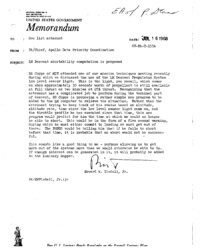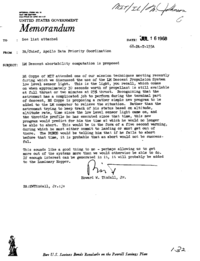See list attachedJUL 16 196868-PA-T-155APA/Chief, Apollo Data Priority CoordinationLM Descent abortability computation is proposed
Ed Copps of MIT attended one of our mission techniques meeting recently during which we discussed the use of the LM Descent Propulsion System low level sensor light. This is the light, you recall, which comes on when approximately 30 seconds worth of propellant is still available at full thrust or two minutes at 25% thrust. Recognizing that the astronaut has a complicated job to perform during the terminal part of descent, Ed Copps is proposing a rather simple new program to be added to the LM computer to relieve the situation. Rather than the astronaut trying to keep track of his status based on altitude, altitude rate, time since the low level sensor light came on, and the throttle profile he has executed since that time, this new program would predict for him the time at which he would no longer be able to abort. This would be in the form of a five second warning, during which he must either commit to landing or must get out of there. The PGNCS would be telling him that if he fails to abort before that time, it is probable that an abort would not be success -ful.
This sounds like a good thing to me – perhaps allowing us to get more out of the systems more than we would otherwise be able to do. If enough interest can be generated in it, it will probably be added to the Luminary Hopper.
- May 29, 1969 – DPS low level propellant light (6.1σ)
- Nov 25, 1968 – LM DPS low level light fixing (4.4σ)
- May 14, 1968 – Aborts from powered descent on the lunar landing mission (3.4σ)
- May 04, 1967 – Some things Ed Copps is worried about (3.6σ)
- Sep 21, 1966 – Apollo rendezvous navigation data edit is too complicated (3.1σ)


